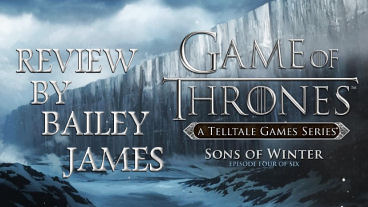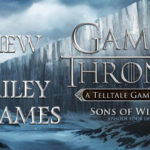
Game of Thrones Episode 4: Sons of Winter Review
Sons of Winter is hobbled by the same failings as its predecessors.







Genre: Point-And-Click Adventure
Release date: May 26, 2015
Note: Spoilers appear in the Conclusion section of this review
How many ways are there to say you’re disappointed in something? I’m worried I’ll run out before we see the last episode of Telltale’s Game of Thrones episodic series. The newest installment, Sons of Winter, is hobbled by the same failings as its predecessors: an inflexible plot and only the barest illusion of free will combined with a lifeless visual language make this title a trudge to the finish line.
By now you’re probably familiar with the motley crew that’s trying valiantly to keep the Forrester clan alive with some semblance of power. We start with Gared, who’s been found guilty of killing a fellow Crow at the wall in the last episode (an unpreventable action, even though I did everything in my power not to eviscerate my attacker). He’s going to be put to death for his crimes — but he isn’t, of course, because then where would this whole plot with the secret grove go, so of course, he manages to escape. Though there isn’t a lot of advancement for Gared here, at least he’s finally away from the narratively restrictive Wall where his behavior was so regulated. He’s been set up for a decent plot next episode out in the wilds, so we can dare to hope for his salvation.
No such luck for Asher and Beshka, who have been folded into Daenerys’ storyline so quickly and seamlessly it’s as though they were never even characters at all. They’ve been tasked with helping the Mother of Dragons free an enslaved city so that they can then hire the sellsword army they journeyed so far for, but who knows how long the gamemakers will insist this duo remain with a major fan favorite character at the expense of developing their own story? There is some interesting character development on Beshka’s part (more on that later), but it’s such a minor occurrence in the midst of fighting for Daenerys’ cause that you might miss it if you aren’t paying attention.
Mira’s story at King’s Landing, meanwhile, rebounds with a surprisingly vibrant little piece of gameplay in which you navigate a royal party to collect valuable information. It’s the most involved you’ll be in any storyline this episode, so it’s worth savoring. Mira is finally showing a bit of spunk and drive which was a long time coming, but that’s no guarantee her newfound courage will lead anywhere productive.
Finally, Roderick continues to fight the enemy forces occupying his home with more success than he had in the previous episode. Or maybe that’s just because I’m finally forcing his character to punch people in the face instead of attempting diplomacy, which has been a tried-and-failed method in all prior situations. It’s a relief to see Roderick finally taking a stand against the Whitehill siege in Castle Forrester, but it still isn’t sufficient for people such as myself who want an all-out resolution instead of another feckless shifting of the pawns in this endless game.
I’ve given the plot plenty of flak in my reviews, so I’ll turn for a moment to another pronounced failing in this series: the visuals. Many people have already expressed their displeasure with the graphic style of animation Telltale has chosen; despite the intended “oil painting” look, the animation quality comes across as muddy and unrefined. But more to the point, for all the game’s obsession with the kind of complex, interwoven narratives that can be seen on the Game of Thrones TV show, Telltale’s effort rarely draws upon the visual storytelling tools television provides. Most of the game is a bunch of people talking and Telltale “films” these scenes in the most boring way possible by framing them in shot/reverse shot. One character will be speaking and we’ll see him/her from over the shoulder of the person who’s being addressed, then we’ll be looking over the initial speaker’s shoulder at the other character as he/she responds. Not only is this a tedious way to view scene after scene, it strips these interactions of any information other than the words the characters are speaking.
The power of visual media is their ability to impart details on a subconscious, instinctual level. A character shrouded in darkness seems mysterious or as though he/she is concealing something important. A landscape shot from a great distance can convey breadth or the scope of a challenge. Two people arguing on different levels (one sitting and one standing, for example) gives us clues as to who is in control of a situation. Game of Thrones makes almost no use of scale, lighting, angles, or other cinematic tools. When Daenerys and Asher are arguing over the use of a sellsword army, even though one of these people is a respected queen and the other an exiled ruffian, it would be difficult to tell who has more bargaining power if you had your computer on mute until a hulking dragon shows up. Not every game needs to aspire to be the next Citizen Kane (though the masterful Life is Strange is giving Orson Welles a run for his money), but a game so grievously lacking in basic elements such as exploration, puzzles, and engaging gameplay should demand more of the elements it chooses to rely on.
Maybe part of the reason this game doesn’t work for me is that I don’t believe in this world. Its morality and its politics are shaky at best and need to be told to us rather than interpreted from the context of what goes on. In short, they are not innate, so it’s impossible to play instinctually. One major plot point of the Asher/Beshka thread of this episode (SPOILERS FOLLOW) is that Beshka is given the opportunity to kill a man who enslaved her as a child. If you choose to go through with the murder, the preview of the next episode reveals that Beshka will be held accountable for the murder of a citizen. But why should this matter when the primary action of this section is the dispatching of a dozen guards in a grisly fashion to complete your mission? Though Daenerys gives us a reason — the masters should be formally put on trial by their former slaves — the moral distinction between these two violent acts is unconvincing and contributes to the difficulty of playing this game with anything approaching strategy.
The hierarchy of Westeros has always been unbalanced in a way that will never be rectified and as a result weakens its ability to tell stories or develop characters. Beshka, one of the game’s most interesting figures, represents an uncommon female presence of physical power that nonetheless gets reduced by the involvement of her male companion. Asher ultimately gets to decide whether she enacts revenge on her former slaver, and the politics of this moment are subtle but reflect upon the philosophy of the game world. We control the outcome of Beshka’s conflict, not because we are embodying her as a character, but rather because we control a man whose desires supersede those of a woman who has previously been billed as his friend and equal. This could have been an effective moment to demonstrate how the uselessness I so often feel as the player could become a storytelling strength and empowering moment for a character who doesn’t care how anyone else’s opinion affects her own agenda. But of course, as with everything else about this game, it was a missed opportunity.
|
+ Plots are finally building to a payoff
+ Mira’s eavesdropping and scheming
– Dull visuals
|

|
Processor: Core 2 Duo 2 GHz or equivalent
Memory: 3 GB RAM
Graphics: ATI or NVIDIA card w/512 MB RAM
Hard Drive: 3 GB available space
Sound Card: Direc X 9.0c sound device
Processor: 2.3 GHz Intel
Memory: 4 GB RAM
Graphics: 512 MB NVIDIA or ATI graphics card
Hard Drive: 3 GB available space

Leave a Reply